
Inmarsat Launches New BGAN Connectivity Solution in the Middle East

By Mark Holmes
Inmarsat has unveiled a new connectivity solution alongside Hytera, Global Beam Telecom and Cobham Satcom to serve businesses in the Middle East. Inmarsat announced the push-to-talk (PTT) offering, BGAN PRISM PTT+, June 28. This satellite-enhanced connectivity solution, now available through Hytera mobile radios, aims to help businesses overcome coverage redundancy and downtime associated with traditional radio systems.
This new unified network solution combines satellite connectivity, radio systems (LMR/DMR) and cellular devices (3G/LTE). Inmarsat hopes this solution will transform customer experience across three key areas: coverage, interoperability, and capability. It believes incorporating satellite coverage will provide exceptional network resilience, enabling seamless switching between radio and satellite while sustaining constant coverage anywhere in the world.
“We are looking forward to sharing BGAN PRISM PTT+ with our customers. As the system integrator, configuring the expertise of the four companies – all of which boast years of experience in their respective fields – provided us the perfect opportunity to bring the ultimate flexible connectivity solution to enterprise customers,” Shabeer Mohammad, managing director at Global Beam Telecom, said in a statement.

OneWeb Reveals Details of IFC Trial on LEO
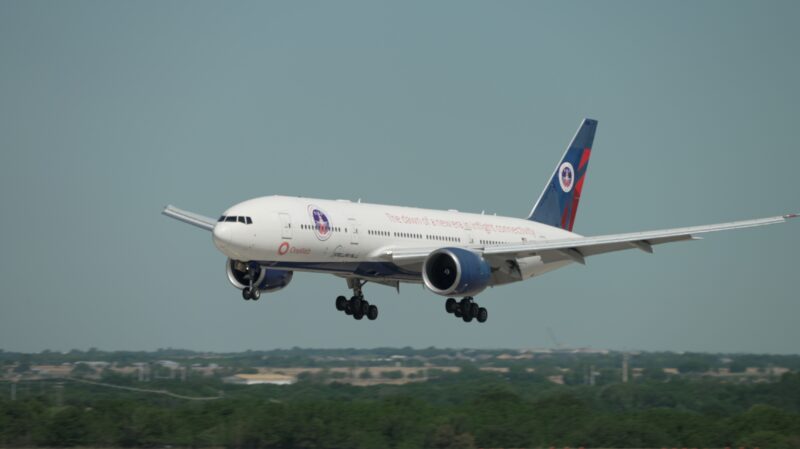
By Mark Holmes
OneWeb and Stellar Blu Solutions have delivered high-speed, low-latency inflight LEO satellite connectivity to a commercial airliner, the two companies announced June 14. This first test flight was conducted aboard a Boeing B777-200LR and took off from Fort Worth Alliance Airport (KAFW), in Texas on May 27th at 15:20 UTC and flew for just over one hour delivering this connectivity experience.
Stellar Blu, has partnered with antenna technology provider Ball Aerospace to incorporate its electronically steered arrays (ESA) into the terminal solution. The new Stellar Blu platform, known as ‘Sidewinder’, will continue flight testing through the remainder of 2022, with a target for certification and availability in mid-2023. This maiden flight represented the culmination of several months’ collaboration between Stellar Blu, OneWeb and Ball Aerospace including ground trials and flight tests.
The test flight crew simultaneously demonstrated the ability to connect Teams calls, 4K YouTube streaming, Netflix, online VR gaming and Nintendo Switch gaming, among other structured performance tests. Maximum speeds of 260Mbps download/80 upload and file transfer scenarios of 5GB demonstrated in approximately 20 seconds. All while operating at well under 100ms of network latency.
“This test flight represents a fantastic milestone for OneWeb. Broadband in-flight connectivity, delivered to a commercial aircraft via LEO satellites and an ESA is now – finally – a reality. Together with our partners Stellar Blu and technology from Ball Aerospace, we are now well and truly on our way to delivering consistently reliable, game-changing, affordable inflight connectivity to commercial aviation users everywhere,” Ben Griffin, vice president Mobility, OneWeb said in a statement.

American Airlines Testing Digital Verification for Airport Security Checkpoints
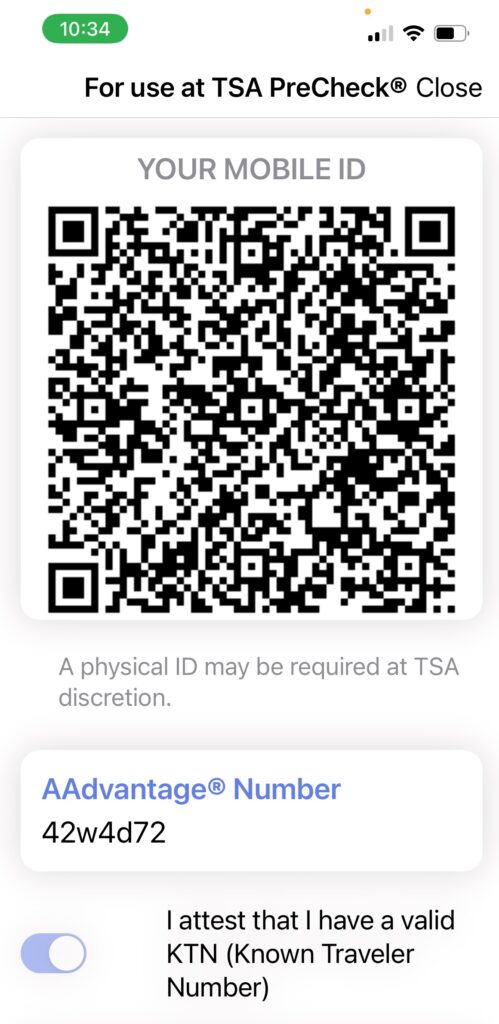
American Airlines recently launched a 60-day pilot project in partnership with the Transportation Security Administration at Dallas Fort Worth International Airport that will evaluate the use of a mobile phone application and facial recognition technology to replace the need for physical identification such as driver’s licenses and passports at checkpoints.
According to a June 22 announcement launching the “American Airlines Mobile ID” pilot, the optional trial will instruct American’s passengers to download the Airside Digital Identity application and verify their identification by scanning their driver’s license or passport and entering their AAdvantage number—American’s passenger loyalty program. Airside’s application uses an identification system provided by Thales that compares the passenger’s passport or driver’s license information with the passport’s embedded near field communication chip or against the individual state’s digital Department of Motor vehicles record for the passenger.
Once this process is completed and the passenger arrives at the airport, they are then instructed to present a QR code on their phone and consent to sharing their mobile identification with TSA. American claims that the entire process at the airport “typically takes less than five seconds.”
Amol Deshmukh, Vice President Solutions, Thales, told Avionics International that the driving force behind the launch of the Mobile ID pilot with American Airlines was to create a more touchless airport checkpoint experience for airline passengers. The Thales executive notes that the technology is not necessarily a new concept, but rather an opportunity for all of the stakeholders involved to understand how they can streamline some of the checkpoints passengers go through in airports.
“Thales is acting as the trusted mobile digital identity technology provider in this case,” Deshmukh said. “We verify that the data coming in is authentic and genuine, and we’re able to verify the issuance trace of each passenger’s ID or passport.”
The American Airlines Mobile ID project, which began in June, is occurring with voluntary American passengers flying out of DFW initially. American has also committed to deploying the technology at Miami International Airport (MIA), Phoenix Sky Harbor International Airport (PHX), Washington Reagan National Airport (DCA), and more airports later this year.
Several other airlines and airports have been increasingly deploying facial recognition, biometrics, and other touchless checkpoint technologies throughout the world as well. The trend was especially accelerated by the COVID-19 pandemic driving airports and airlines to seek methods for reducing passenger touchpoints along their journey.
Another aspect of deploying the American Airlines Mobile ID technology considered by Thales and all of the other partners involved is the privacy of passengers’ personal information.
“The entire process is consent driven from a passenger standpoint. They’re consenting to share the data through this QR code from their phone with TSA and TSA only. Once their Mobile ID is verified through our system, that Mobile ID only exists within their phone, you cannot duplicate it, and sharing it with TSA occurs through an encrypted data feed toward the TSA CAD device. TSA then performs their own verification at the airport, and does not actually store that data once they’re done it gets deleted.”
American has not provided a timeline as to when they will consider expanding the Mobile ID technology to other airports.

SpaceX Works to Educate Airlines on Virtues of Starlink and LEO In-flight Connectivity
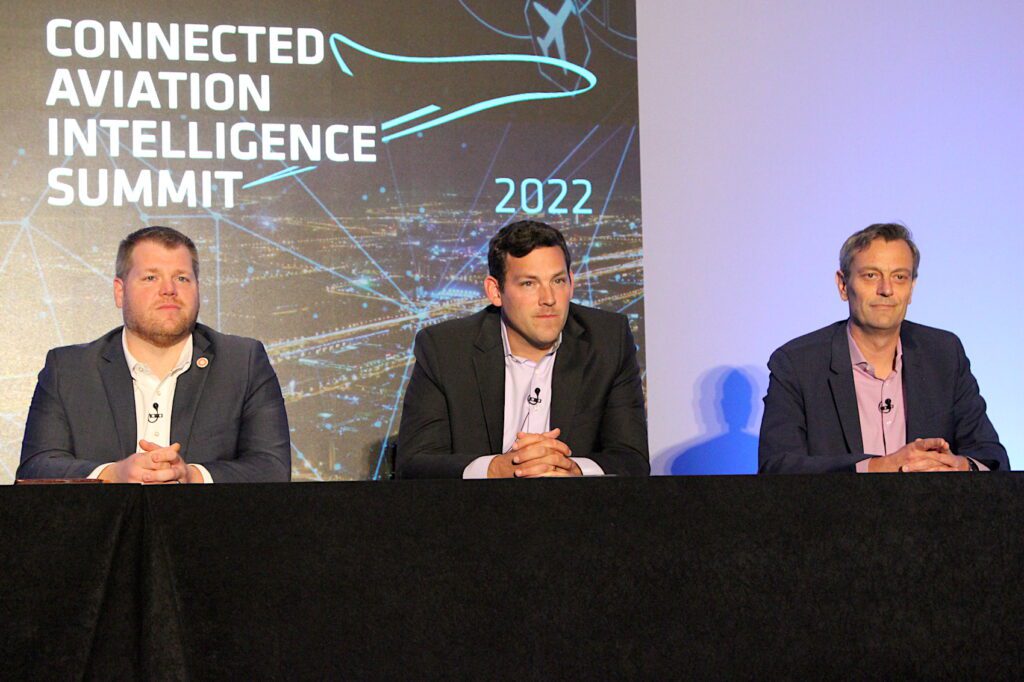
By Aaron Karp
SpaceX’s top Starlink executive is leading the drive to convince airlines that Low-Earth Orbit (LEO) satellite-powered in-flight internet services would be superior to current offerings in terms of speed, ease of use, and the ability to provide widespread, consistent coverage—even for transoceanic flights.
Speaking on a panel at the Connected Aviation Intelligence conference earlier this month, Starlink Vice President of Commercial Sales Jonathan Hofeller said current in-flight internet services powered by Geostationary (GEO) satellites will not be able to keep up with the connectivity demands of airline passengers, particularly younger consumers.
The Starlink constellation of more than 2,330 LEO satellites powers internet service for 400,000 consumers and enterprises in 32 countries. Starlink this year has inked deals with Hawaiian Airlines and JSX, a California-based Part 135 public charter operator, to begin equipping aircraft with its LEO-powered in-flight connectivity (IFC) service in 2023. Hawaiian’s service will be free for passengers.
Hofeller said aviation is a potentially significant market for LEO-driven internet services that Starlink is actively targeting, noting that beyond the Hawaiian and JSX contracts are “several more [airline agreements] in the works.”
He added: “We’re obsessive about the passenger experience. We’re going to be on planes here very shortly, so hopefully passengers are wowed by the experience.”
The key differentiator between GEO- and LEO-powered internet services for airlines will be the low latency of LEO options, Hofeller said, explaining that consistent, high-speed connectivity comparable to the “home experience” is not possible with GEO satellites.
“We’re transitioning from a download-heavy model to more of a symmetric type of environment,” he said. “If you look to the future and you believe two-way communication is important, then that latency becomes extremely important, whether it’s co-editing documents or doing real-time FaceTime calls … There are a lot of applications where latency is super important to being productive on an aircraft.”
For this reason, airlines will consider moving to LEO-driven services, according to Philippe Schleret, vice president of aviation for Telesat, the Canadian satellite operator that aims to equip aircraft with LEO IFC capabilities by 2026. “We see a lot of excitement with the airline community about the prospect of having the IFC services over LEO networks,” he told the Connected Aviation Intelligence conference. “It’s really about bringing a superior quality of experience at an affordable price. [LEO can] enable free services with higher throughput and a lot of features. We’re pretty bullish about the prospect of having the vast majority of airline IFC traffic over LEO ultimately.”

Another panelist, OneWeb’s Market Development Director for Business Aviation Jason Sperry, predicted that LEO-powered IFC will be commonplace in the 2030s. “By 2030, you’ll see a considerable amount of aviation traffic on LEO networks,” he said.
Like Starlink, UK-based OneWeb aims to be offering LEO-driven IFC services on aircraft by 2023, but it has not yet announced any agreements with airlines.
Sperry said airlines are concerned with what he calls “the five Cs” when it comes to IFC: cost, coverage, capacity, connection, and consistency. All of these will be improved by LEO-based services, he added.
“You’re really going to see an adoption by the airlines,” Sperry said. “The passenger experience matters and airlines really want to provide a passenger experience that will continue to allow that customer to come back to that airline and not go to another airline. The younger generation is pushing the demand and the expectation to have that aboard the aircraft. Airlines are really looking forward to getting on with LEO.”
Hofeller noted that Starlink’s current consumer-based internet offering provides service within a country’s borders, but airline service will be provided across borders. “The deal we signed with Hawaiian Airlines opens up the transoceanic [coverage],” he said. “So, we have our inter-satellite links, which enables that capability, and that system is being deployed as we speak. We’ll be able to be servicing folks intercontinental early next year.”
Sperry said a big hurdle to overcome is a lack of awareness among airlines about LEO satellites and the IFC capabilities they can provide. “From our perspective, education is important,” he explained. “Each airline has a different kind of mindset in what they understand about the [LEO] networks … The generation now and the generation upcoming really demands this on aircraft.”
He added it is “not a question of if airlines are going to do it, but when.”
Hofeller said many airlines currently have a view that technologies such as IFC should be upgraded only every 10 to 12 years. “That’s completely misaligned with how technology develops,” he said, adding: “If you’re ultimately looking at what the best thing is for the passenger experience, you have to have the flexibility to get the best product for them” as soon as it is available.
Hofeller predicted airlines will be convinced when Starlink’s services are on aircraft and “we show airlines the technology and what can be done.” He added: “The product that we have is simple, it’s lightweight, easy to install, and easy to de-install.”
He said Starlink’s LEO satellite constellation will continue to grow and provide increasingly robust coverage. The company is building eight satellites a day at its Seattle-area manufacturing facility. Hofeller added that Starlink is telling airlines it will handle all aspects of its service, enabling fast troubleshooting.
“I think the beauty of our system is that we are completely vertically integrated,” he explained.
But some airlines will need to be persuaded to end current IFC contracts early, Hofeller said: “I know the aviation industry is focused on long-term cycles and that doesn’t necessarily align with the adoption of new technologies, but we’re hoping to disrupt that [and convince airlines] not to be stuck into a legacy contract that’s seven years old.”
Just as airlines need to learn about Starlink and LEO satellites, Starlink needs to become more familiar with the airline industry, Hofeller conceded: “We’re new at this. We’re going to adapt … We’re not stuck in a particular way.”

The FAA Moves to Zero Trust Strategy for Preventing Cyber Attacks
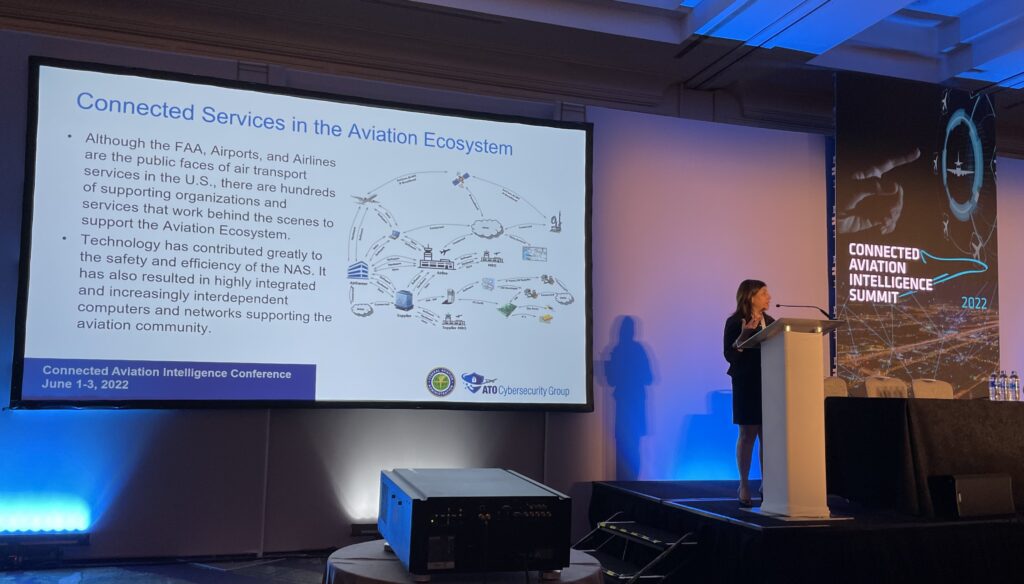
Luci Holemans, ATO Cybersecurity Group Manager at the Federal Aviation Administration, spoke about what initiatives the FAA is taking to promote cybersecurity at the 2022 Connected Aviation Intelligence (CAI) Summit in Reston, Virginia, last week. One key change is a shift to a Zero Trust architecture and focusing less on network-based perimeters as a cybersecurity strategy.
Like other U.S. federal agencies, the FAA as part of the broader U.S. Department of Transportation has been tasked with transitioning to a Zero Trust cybersecurity architecture under an executive order issued last year, although has been transitioning to this approach since 2020 when it was discussed during the 2020 FAA Cybersecurity Symposium. A basic premise of the Zero Trust architecture approach to cyber securing air traffic systems or critical infrastructure and assets managed across any industry is to assume networks are compromised and focus on the defense of a given application’s data.
The FAA is exploring multiple strategies to stay ahead of a constantly changing environment and to maintain continued safety and resiliency. It’s necessary, Holemans said, to take into account not only the cloud technologies embedded into this ecosystem, but also unmanned aircraft systems (UAS) and a commercial space that is taking off.
To ensure strong defenses, Holemans said, cyber needs to be integrated into our connected technology, and there must be collaboration between the government, industry, and academia. The cybersecurity environment is so dynamic that it is difficult to keep up with new challenges without collaboration, she said.
Cybersecurity has to be addressed from the start. This means considering the necessary requirements with any new system or service, and making sure that these requirements are embedded early on rather than after the system is deployed. “With legacy systems,” Holemans added, “we ensure that we put those cyber requirements and solutions in place to maintain safety.”
New cybersecurity threats and vulnerabilities are identified on a daily basis. Dealing with this environment, then, needs to include a flexible and efficient approach to finding and establishing solutions.
“Acquisition, especially in a government environment, is typically pretty slow,” she noted. “We can’t take years to address cyber issues that emerge on a day-to-day basis. How do we change acquisition processes and shorten that time frame to deploy a solution?” To meet the needs of today’s cybersecurity environment, a five- to ten-year-long timeline of acquisition no longer suffices; a six-month turnaround time would be more appropriate, Holemans said.
The FAA’s objective is to maintain both safety and resiliency from an aviation standpoint. “We are looking at cyber events 24/7, and have resources dedicated to identifying events that could potentially be cyber related—anything perceived as a system failure, or a service issue,” she remarked. “We are trying to stay on top of new policies that are coming out, new executive orders.”
For recent cybersecurity threats like JetBrains or SolarWinds, the reaction needs to be even quicker than a six-month timeline. When these new vulnerabilities and threats arise, they need to be addressed within weeks, not months. Taking immediate action can be a challenge in the aviation industry, however, says Holemans.
“We don’t change things quickly—and with good reason. You want to test things out before putting anything into the operational environment. At the same time, we try to stay ahead of [these threats].”
There are more threats cropping up now than ever before in the current dynamic landscape of cybersecurity. Technological capabilities like 5G and the evolving Internet of Things (IoT) have led to increasingly sophisticated, malicious cyber-attacks against critical infrastructure and a wider range of potential threat actors.
“It really widens the scope in terms of who is able to potentially do an attack, who else can then take advantage of those new technologies,” Holemans explained. “But we’re also using those same technologies to overcome these challenges.”
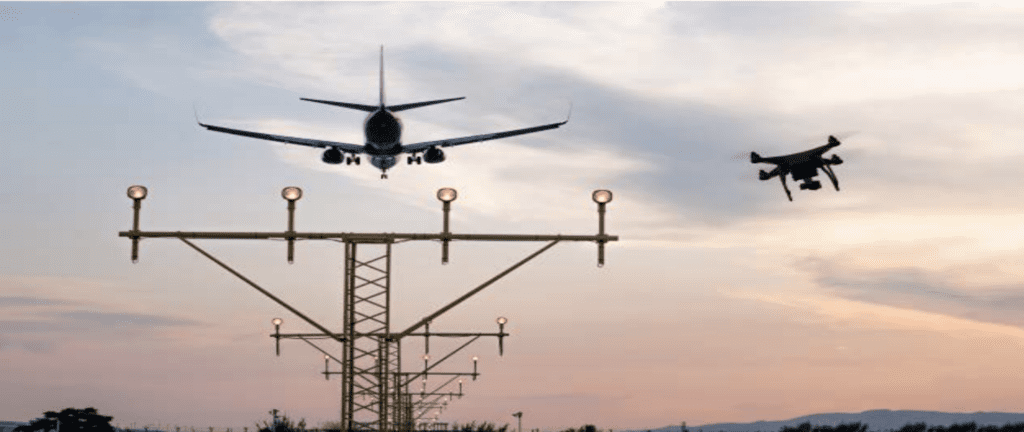
The FAA is changing its cybersecurity defense strategy to depend less on network-based perimeters. Holemans shared that the agency is moving towards a Zero Trust architecture that includes authentication and segmentation of users and resources in a network as well as monitoring activity within the network. This strategy of Zero Trust aims to reduce an intruder’s ability to enter the operational environment. If an intruder does get through, Holemans said, the impact on other systems and services is significantly limited.
The Zero Trust strategy includes considering all requests as if they originated from an open network before verifying them. All devices and users undergo dynamic evaluation based on trust scoring. Within the Zero Trust architecture, perimeter boundaries are not eliminated but rather reduced in size. The strategy uses real-time intelligence and analytics that will enable the FAA to promptly address any anomalies.
The FAA is also evaluating multiple enterprise cybersecurity capabilities in order to protect mission critical systems. These capabilities include managed enterprise security monitoring, security enterprise asset management, centralized National Airspace System (NAS) software security management, and managed enterprise security protections.
The NAS software security management provides centralized capability for security patch and protection updates. Holemans explained further: “Instead of having the different systems and programs take something that’s been developed and putting it into an operational environment, we’ve created an environment within the operational area that allows those systems and services to get those new pieces of software where it’s already been tested and checked for any kind of malware.”
Holemans also touched on the FAA’s intentions for ensuring cybersecurity with UAS, an area that is growing rapidly. The agency is still working to determine the best way to incorporate unmanned systems into daily operations in the NAS, she said. “It is more industry driven, but as UAS becomes another target, we are trying to understand how to incorporate those pieces of information into the operational environment. We are involved in some of the requirements for UAS, but in terms of monitoring it, registrations, [the FAA is] still on the outside of that.”

Cloud-Based Flight Management Systems for Next Generation Aircraft

GE Aviation, SmartSky Networks, and Mosaic ATM have been working together since January to connect cloud-based flight management systems (FMS) with airborne FMS. At the Connected Aviation Intelligence Summit last week, representatives from each company revealed the progress made through this collaboration and what they expect to achieve in the coming months.
The teams from GE, SmartSky, and Mosaic are currently finishing the experimental plan and software development, which should be completed within the next two to three months, according to Todd Kilbourne, Senior Program Manager, Mosaic ATM. In August, they expect to begin simulations of the use cases for trajectory negotiation at SmartSky’s lab in Virginia. Following the successful completion of these simulations, a flight test will be conducted to validate the results.
“We’ve set it up so we can implement this digital twin on three aircraft in a simulated lab. We’ll have one aircraft for the flight test and two simulated aircraft that have this digital twin concept in the simulation lab, and we’ll see how all that works together,” Kilbourne said.
In 2023, the collaboration may begin exploring additional use cases beyond trajectory negotiation like conflict detection and continuous descent arrivals. With the digital twin concept, said SmartSky’s Britton Wanick, VP Marketing & Partnerships, “we’re able to take a cloud-based FMS and have information from the airborne FMS, but also have access to a lot more [data] and share it across the entire ecosystem to address a variety of different use cases.”
These efforts are part of a NASA Innovation Award. Phase I of the project included SmartSky and Mosaic; GE Aviation joined as a partner for Phase II, which will continue until the end of 2023.
“We brought in GE Aviation because they have a modular functional FMS that is very compatible for this project,” explained Kilbourne. “It had an onboard component but also a component that could be easily hosted on the cloud.”
Mosaic, an air traffic modernization and optimization company, is building extensions to the cloud that will add functionality and is also creating interfaces to simulations of an air traffic management (ATM) system and an airline operations system.
In joining Mosaic and SmartSky for Phase II of this project, GE Aviation’s team made it a priority to enable offboarding of capabilities and reduce reliance on the computer onboard the aircraft. One of the problems in the aviation industry is that computing power installed on an aircraft rapidly becomes outdated, remarked Gary Goz, Navigation Systems Product Director at GE Aviation. “We want to add new capability and new functionalities to the flight management system; we’re constantly adding new capabilities, [but] we run out of computing resources very quickly,” he said.
Addressing this issue involves considering what safety-critical pieces are required to be onboard. Goz mentioned flight planning as an example of an area where efficiency can be improved. Pilots carry electronic flight bags (EFBs) onboard to use for finding optimal flight plans, but the information they are using isn’t available to the avionics system. “We’re striving to connect data that’s available outside avionics into the avionics themselves, and being able to use that technology outside of the avionics system,” he explained.
GE already has the capability to simulate the FMS on the ground—a digital twin version, essentially—and their current focus is linking onboard systems with the simulated system.
There is aircraft data that is only available to the aircraft, including optimal trajectory models, Kilbourne added. Synchronizing that data with a cloud-based digital twin version would result in a more accurate model. The high-resolution weather data, air traffic constraints, and other information that is only available on the ground will enable automation systems to provide more accurate trajectory predictions.
“The ground automation systems involved in air traffic control, air traffic management, and flight operations all use different customized trajectory models for calculations. I’ve been working on these for over 25 years and constantly hear things like, ‘I wish we had more information from the aircraft,’” said Kilbourne.
Providing more information from the aircraft to air traffic control would improve the ability to deconflict routes, Gary Goz stated. This information includes fuel levels, aircraft weight, and performance characteristics, which are not currently available to air traffic control. By offboarding the ability to optimize routes and deconflict traffic, he added, aircraft will be able to avoid common problems like holding patterns and entering congested areas.
Goz noted that for the GE Aviation team, the concept of a cloud-based FMS is part of a larger envisioned ecosystem. Such an ecosystem includes connected flight management systems solutions like providing the pilot’s EFB with the same interaction and data that are provided to the digital twin on the ground or in the cloud. When you have these components stitched together, Goz said—”The cloud, connected FMS, ATC—you have all the same data at your fingertips to be able to make decisions about trajectories and deconfliction.”
There is the potential for increased risk when enabling such capabilities, he commented. Cybersecurity is a key issue that the team has taken into account from the start.
Advanced air mobility (AAM) is an emerging space of interest for GE’s Aviation division, Goz noted. “There’s a need there,” he said. “It’s still very fluid. Things are starting to solidify in some areas, especially around how we manage traffic. This technology could grow quickly once you’ve proven it out in that space you could advance it.”
Mosaic’s Kilbourne is also confident that the cloud FMS technology and architecture will transfer to AAM. Although the space is slightly different from commercial and business aviation, there is compatibility in AAM with the developments that Mosaic, GE, and SmartSky are working on.
“The FAA doesn’t necessarily control the traffic in some of these UAM corridors,” Kilbourne said. “They have regulatory oversight, but there will be centers where the service providers that oversee these UAM airspaces will handle operations for flights within their control.”
In addition to the progress made in collaboration with GE and SmartSky, Todd Kilbourne shared that Mosaic ATM has been awarded a new Small Business Technology Transfer (STTR) Phase I from NASA to collaborate with a university partner. The focus of this project is creation of a toolkit for urban air mobility (UAM) communications management. The first component of the toolkit is a path loss prediction tool using a machine learning (ML) model, which will be trained using data from ray tracing software.
“We’re also going to develop an architecture for UAM comm that would be a robust architecture, could combine satellite communication, ground communication, and even air-to-air communication. [Our] recommendations could move the industry forward in designing a useful, robust architecture for UAM,” he shared.

How Much Value Does In-Flight Connectivity Offer Ultra Low-Cost Carriers?
In-flight connectivity (IFC) topics were a central point of focus during last week’s Connected Aviation Intelligence (CAI) Summit, held in Reston, Virginia. Representatives from Air Canada, Panasonic Avionics, Intelsat Corp, and Stellar Blu Solutions discussed the value of satellite technology for in-flight entertainment (IFE) offerings. Another panel including representatives from Breeze Airways, El Al Airlines, and ST Engineering iDirect featured next-generation strategies for increasing bandwidth to support in-flight connectivity (IFC).
On the final day of the CAI Summit, Colton Snow, Vice President of Product and eCommerce for Sun Country Airlines, delivered the keynote presentation regarding the airline’s current un-connected in-flight passenger experience strategy. There are multiple use cases for IFC, Snow conceded, such as enabling connectivity for the cabin crew to increase aircraft safety and reliability, or for processing on-board transactions and eliminating issues with declined payment methods. However, he said, none of these are compelling enough at this point to drive an investment from Sun Country into the technology.
“In the long-term, there are catalysts that will move us to in-flight connectivity,” Snow explained. One of these is a change in customer expectations. Fewer than 0.5% of passengers from Sun Country mention Wi-Fi in their feedback submitted through surveys. At some point in the future, once more customers include access to IFC in their decision-making criteria, it would justify an investment into the technology.
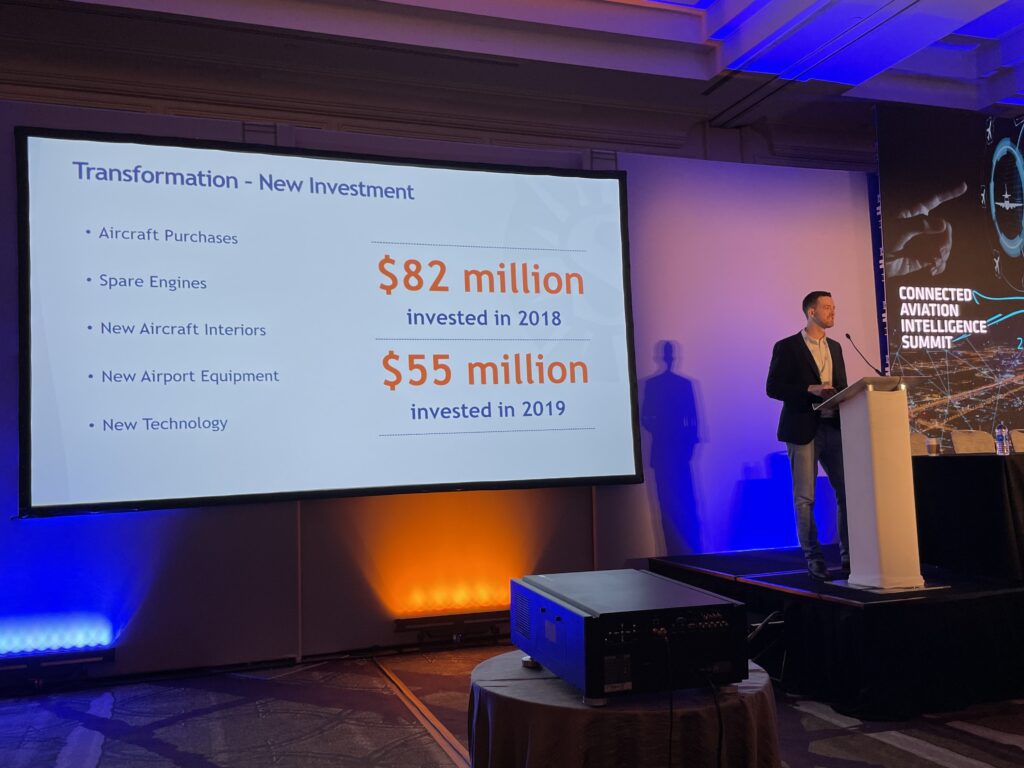
A significant portion of the customer base for Sun Country Airlines is leisure travelers; 97% of the markets served are seasonal. Popular destinations include Aruba, Honolulu, Turks & Caicos, and St. Thomas. For leisure customers, Snow stated, streaming and entertainment cover the bases for their in-flight experience. The target customer demographics for the airline are 46- to 51-year-olds, married, and earning a household income of $97,000 to $107,000. “These customers ultimately care about getting value,” he said. They value low fares and a good in-flight experience. As an ultra low-cost carrier (ULCC), Sun Country has to maintain low costs to ensure low fares. Snow explained, “This creates a high bar for capital intensive investments in the onboard experience, like in-flight connectivity, that may not have a tangible or direct ROI that we can manage or own.”
To compete with other ULCCs such as Allegiant and Frontier, Sun Country aims to balance low fares with a positive in-flight experience by offering a free beverage service, in-seat power, and free streaming of IFE content to passengers’ personal devices. The company had three choices in their approach to IFC and IFE, Snow explained: do nothing, offer streaming of IFE, or offer both IFE and internet access. For leisure travelers that are visiting friends or going on vacation, having Wi-Fi on board does not offer as much value as the option to watch TV or movies while in flight. “Lots of folks travel other airlines for business and expect connectivity,” he added.
“We experimented with in-flight tablets but found they required more maintenance, and most folks prefer to bring their own tech onboard like smartphones, tablets, or laptops,” Brian Davis, chief marketing officer for Sun Country, told Avionics in an emailed statement last year.
The cost of offering in-flight connectivity is also major point of consideration for the airline. With such a strong focus on low fares, the cost passed on to customers for IFC must be minimal. “We would really have to go forward with a strategy where it was baked into the cost of the fare,” Snow remarked in his keynote presentation.

Wizz Air to Add fflya In-Flight Connectivity to UK Fleet
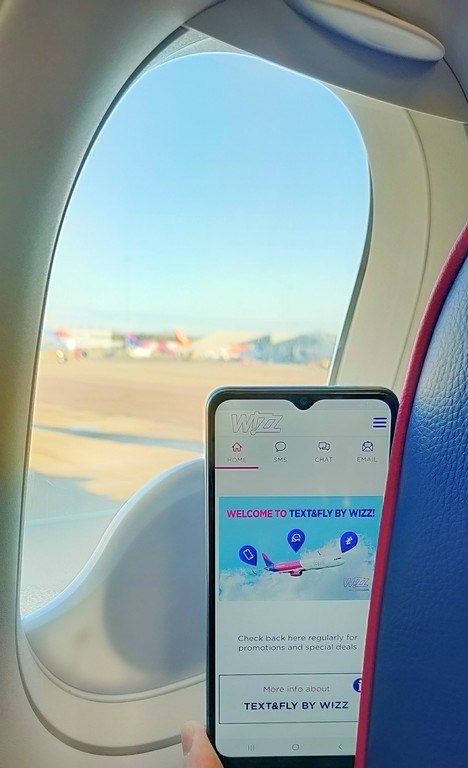
Wizz Air, the Hungarian low-cost airline, is adding in-flight connectivity to its U.K.-based fleet of Airbus A320 and A321 aircraft under a new agreement with AS-IP Tech, Inc.
Under the new agreement, Wizz Air will integrate AS-IP Tech’s fflya Bluetooth platform into its mobile app and provide free SMS, WhatsApp messaging, and email to its passengers. According to AS-IP Tech, their system is enabled by installing one single Bluetooth wireless access point and two window-mounted antennas affixed to both sides of the aircraft.
According to an update on the technology shared by AS-IP Tech in November, some Wizz Air passengers have already been using the technology on U.K.-based A320 and A321 routes operated by the airline. Although AS-IP Tech provides very little details bout how its technology works, their antennas and Bluetooth access points leverage connectivity provided by the Iridium Next satellite network.
In addition to passenger connectivity, fflya also transmits operational telemetry data from the A320 and A321 fleet operated by Wizz Air. Wizz Air is promoting the upgrades to its U.K.-based fleet as “TEXT&FLY BY WIZZ.”
“Following months of successful flight testing, we are delighted to be selected by Wizz Air pioneering our new generation of in-flight connectivity,” ASIP Tech President Ron Chapman said. “We look forward to working with WIZZ and building on our unique messaging technology that provides the foundation for enhanced services including, inflight live payment, real-time telemetry and E Commerce.”
The connectivity and messaging services will be provided free of charge to customers, according to Wizz Air.
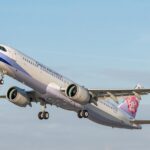
China Airlines Adds Second Screen 3D Moving Map Technology to A321neo Fleet
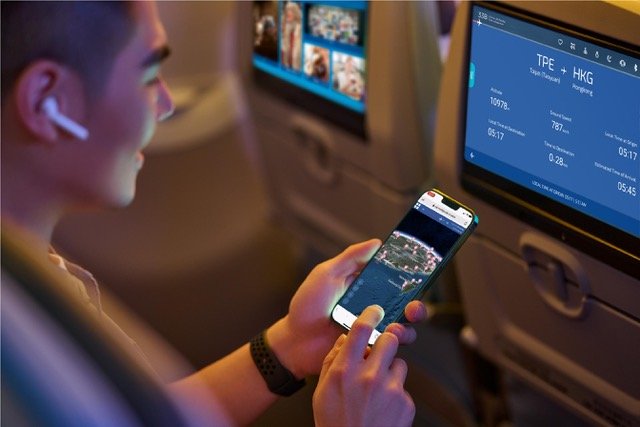
China Airlines is adding FlightPath3D’s “any device, any platform” three-dimensional second screen technology to its Airbus A321neo fleet, according to a June 8 announcement from the California-based provider of in-flight entertainment (IFE) technologies.
The “any device, any platform” from FLightPath3D is being added as a mobile device extension to the Safran seatback IFE system featured on China Airlines’ A321neo aircraft as part of the Chinese carrier’s plan to offer the same in-flight experience for passengers across its A321neo, A330-300, and B737-800 cabins. Jeremy Chang, Vice President of China Airlines’ corporate development office, describes FlightPath3D’s technology as the “the most advanced 3D map available.”
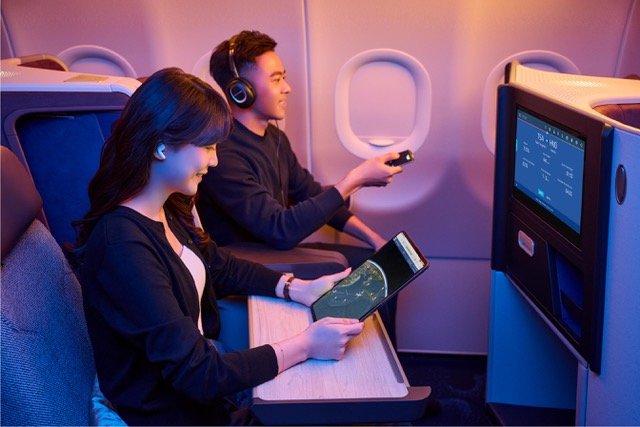
“FlightPath 3D’s engaging moving map technology on our second screen, plus the flexibility to add the kids’ app on our IFE, shows FlightPath3D’s ability to work with us to drive our initiatives of providing the best inflight experience for all passengers,” Chang said.
China Airlines operates a combined fleet of 86 aircraft, including 64 passenger jets and 22 freighters. There are five total A321neo aircraft currently being operated by the airline under a previously announced order for 25 neo aircraft placed with Airbus. The airline received its first A321neo on lease from Air Lease Corporation (ALC) in November.
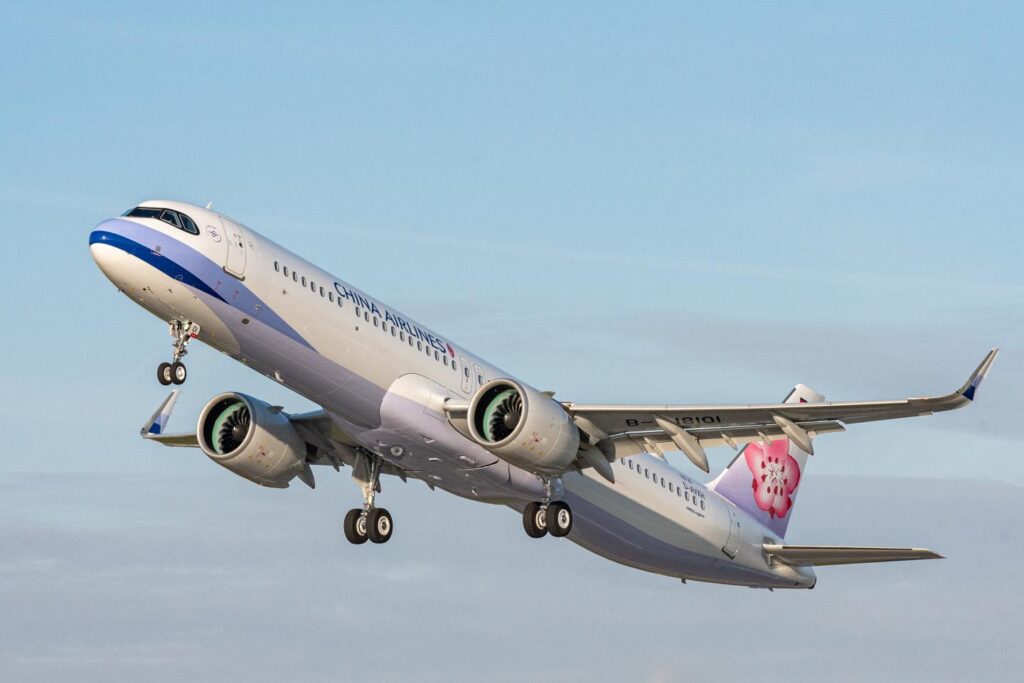
FlightPath3D describes its moving map technology on Wi-Fi-enabled mobile devices as being capable of allowing passengers to “roam in a fully 360 degree horizontal by 180-degree vertical landscape.” The company has expanded the features included with its 3D moving map technology, including geographical points of interest, a content management system, shopping micro-sites, and a range of other ancillary revenue applications as well.
“China Airlines recognizes the second-screen experience is essential to captivate passengers and keep them engaged throughout their travel experience,” FlightPath3D President Duncan Jackson said, commenting on the new announcement. “Having a full, 3D map in your hand while watching a movie on your seatback is a game-changer for the passenger, and opens the doorway for innovative opportunities for the airline to reach its customers.”

Airbus is Conducting R&D on Optical Satellite Links for Ground, Aircraft, and Other Satellites

By Jeffrey Hill
Airbus Americas Vice President of Research and Technology Amanda Simpson confirmed Friday that the manufacturer is conducting research on inter- and intra-satellite optical link technology with universities in California.
During a speech at the Connected Aviation Intelligence Summit in Reston, Virginia, Simpson told attendees that she had just returned from a trip to visit Airbus’ research partners to learn about the latest developments in strengthening satellite communication signals to ground systems, aircraft, and other satellites.
“This is all about making automation possible,” said Simpson. “Today’s cockpit is already very automated, but Airbus sees the future of aviation relying much more heavily on AI and machine learning for more decision-making during flight. This added autonomy involves AI making choices based on data that may not give us the same result every time. This creates a question that is challenging to answer — How do you learn to trust that algorithm?”
Airbus has several research partners in California, including the University of Southern California, with which it partnered to establish the Airbus Institute for Engineering Research (AIER) in 2013. The Institute is based at the USC Viterbi School of Engineering.
Simpson, who also serves on the American Institute of Aeronautics and Astronautics’ Systems Engineering Technical Committee, said Airbus and its research partners are exploring new methods on how to strengthen secure bandwidth connections within next-generation satellites and to and from other ground and aviation systems.
“We’re looking at direct optical links between satellites,” she said. “Laser communications between satellites are limited to the strength of the signal. But we’ve been looking at phase modulation for the beams in order to increase the power of that signal. We’re also conducting research on how that would work in the atmosphere.”
In addition to working with universities, Simpson said Airbus is working with certifying agencies around the globe to establish trust in satellite-powered AI and ML applications. “I’m not just talking about aircraft,” she said. “We want to connect helicopters and satellites and we want to trust that those connections work securely.”
Airbus Americas serves as the U.S. arm of its Airbus S.A.S parent company based in France. The division is central in the development of Airbus’ Unified Airbus Network Solution, which is designed to utilize satellite data and networking technologies to help reduce airlines’ operating costs. Airbus sees autonomous flight as the key to fuel cost savings and operational efficiencies for airlines, supporting pilots in strategic decision-making and mission management.
Simpson joined Seneca Giese, director of Business Development at Cirrus Aircraft and Francesca Stockton, Aviation Connectivity product manager for Verizon Robotics, at the event for talks about its next-generation technology development plans.
Cirrus Aircraft has long been a customer of Iridium Communications, which powers its Cirrus Global Connect service, providing worldwide weather, satellite phone and text messaging services to the aircraft cabin. In January 2020, Cirrus released its Cirrus IQ app, which gives aircraft pilots the unique ability to check the status and performance of their aircraft remotely from their smartphone with a globally accessible digital connection. Cirrus IQ provides pilots with pre-flight status information, including fuel and oxygen levels, battery voltage, oil temperature, aircraft location, and flight hours.
Verizon Robotics acts as a connectivity use case factory for the aviation world. It is developing technologies and mixed fleet robots that create maps from drone data and provide autonomous navigation capabilities. In October, Verizon Robotics’ cellular carrier parent company announced it formed a collaborative partnership with Amazon to expand the carrier’s rural 5G and 4G LTE networks via Amazon’s upcoming Project Kuiper constellation.


